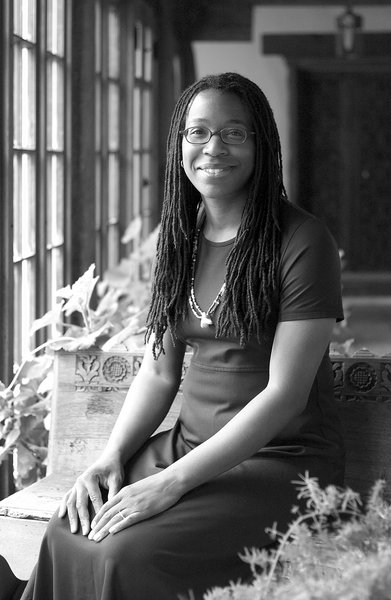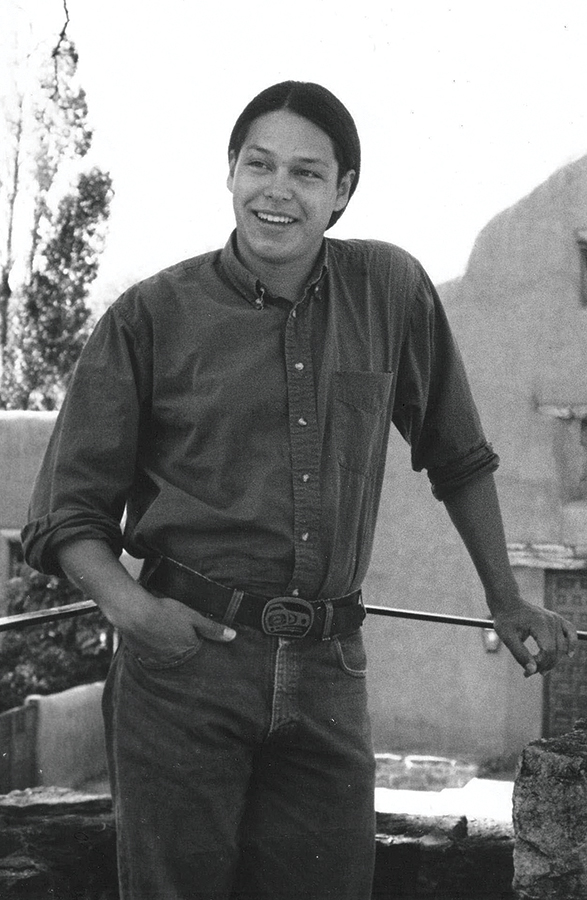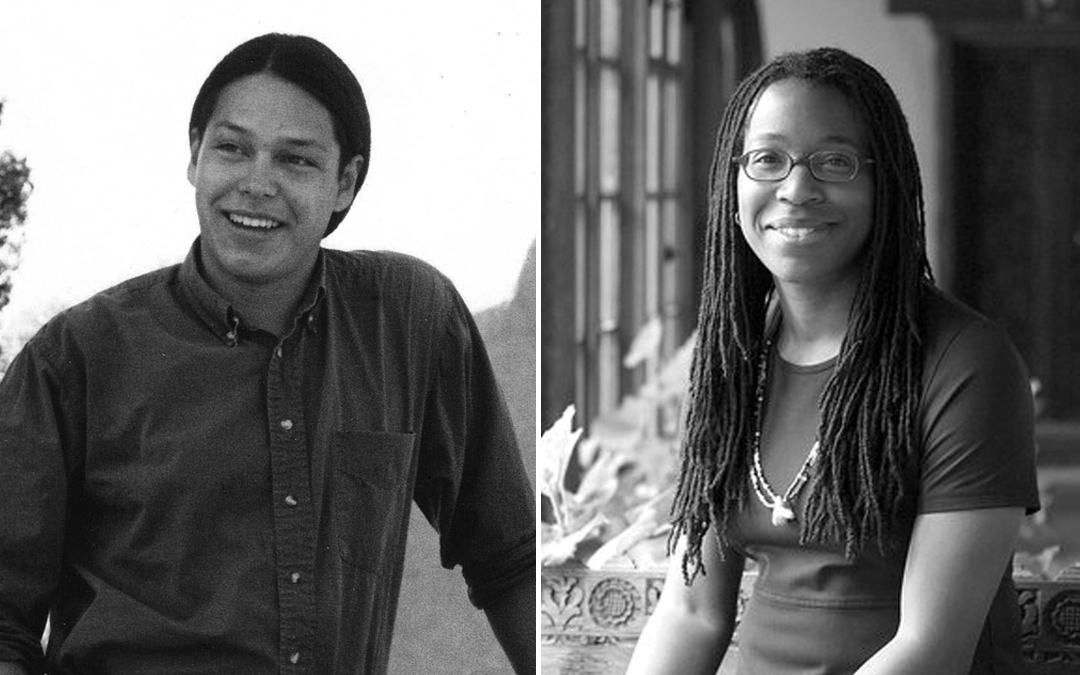In celebration of fifty years of Resident Scholars at the School for Advanced Research (SAR), we will share a series of posts about the program and the scholars over the years.
So far, two SAR Resident Scholar Fellows have won the National Book Award: Tiya Miles in 2021 for her book All that She Carried: the Journey of Ashley’s Sack, a Black Family Keepsake and Ned Blackhawk in 2023 for The Rediscovery of America: Native Peoples and the Unmaking of U.S. History.
Recently, they took a moment from their very busy schedules to share a little about their residency experiences at SAR, how they impacted their lives, and also a few words about how they influenced each other.

Tiya Miles during her residency at SAR in 2007. Photo courtesy of SAR.
Tiya Miles, School for Advanced Research Fellow, 2007-2008
“I barely made it into the program! My husband, the cultural and community psychologist Joseph Gone, received an SAR fellowship to develop his work on Native American mental health and wellbeing. The director at the time, the wonderful historian James Brooks, wanted to make it possible for me to come, too, along with our twin daughters, who were three years old. Brooks invited me to apply for a partial fellowship, and my department chair at the University of Michigan matched the funding. I am immensely grateful for the creativity and support of these angel administrators!
I had never spent time in the Southwest before. The light was captivating, and the SAR campus was magical. The beauty all around, combined with the incredible gift of time, spurred my writing. I made great progress on my second book, The House on Diamond Hill: A Cherokee Plantation Story. I drafted all the content chapters at SAR and finished the introduction and conclusion the following summer after my return to Ann Arbor.
During that year, our twin daughters attended a sweet nursery school with the best name I have ever heard: The Gentle Nudge, which was recommended by SAR staff. Our little ones had their first Spanish lessons in a charming adobe schoolhouse.
I have so many memories from that year. The one that comes to mind now is my delight at our first snowfall. I hadn’t imagined that we would have winter storms in New Mexico. The snow was gorgeous in the Santa Fe light. My daughters wanted to play in it, so we bundled up and went outside to build a snowperson. The kids named her Snow Girl on Roller Skates!
And here’s a secret that few people knew: our family grew at SAR. The experience was just that special. I gave birth to our youngest child the following fall. I still feel a little self-conscious about my photo on the SAR fellows’ wall because I was pregnant in the picture—far enough along for the bump, but not far enough so that anyone knew.
Since winning the National Book Award, my life has gotten a lot busier! The readership for my work has dramatically increased, which is a joy and an honor, even as it is difficult to keep up with all the email and requests for meetings, interviews, and talks. I won the award in 2021, during the height of Covid, so my attendance at the ceremony was virtual. Still, I remember the shock of hearing my name announced by Nell Irvin Painter, one of my academic role models. Seconds beforehand, I had been waiting in the virtual green room with one other writer, the novelist Jason Mott. There was a sudden kind of intimacy in sharing that moment as we waited in suspense. Within minutes, we learned we were the winners in our categories. It was both thrilling and startling. Amazingly, Jason was chatting with me in the virtual messaging system during the ceremony, saying that he was colleagues and good friends with the poet Malena Mörling. Malena was a research associate during my year at SAR! A conversation with her about the poetics of dwelling places influenced how I wrote about the plantation house at the center of The House on Diamond Hill and the novel I later wrote based on the research for that history book, The Cherokee Rose.
I met Ned Blackhawk for the first time at a conference in 1998. I was a dissertation fellow at Dartmouth that year, and I was struggling to get started. Weeks were passing by, and I just couldn’t bring myself to put words on the page. I couldn’t imagine being able to produce a study of dissertation length. I remember that my conversation with Ned inspired me to feel that I was not alone and that I had to leap into the writing. Since that time, Ned and I have been colleagues in the field of Native American and Indigenous studies. We worked together briefly as co-editors (with Fred Hoxie and Neal Salisbury) of the Cambridge University Press Studies in North American Indian History series. And, of course, we have touched base over the years at conferences and campus visits.
I have long admired Ned’s first book, Violence Over the Land, for its incisive conceptual framing. I returned to it a handful of years ago when I was writing my history of Indigenous and Black enslavement in the Midwest, The Dawn of Detroit.”

Ned Blackhawk during his residency at SAR in 1996. Photo courtesy of SAR.
Ned Blackhawk, Katrin H. Lamon Fellow, 1996-1997
“I applied to the SAR Resident Scholar Program as a graduate student at a public university where funding was a challenge. I was extremely fortunate to be selected and to have had the experiences I had in Santa Fe. It was the perfect environment to begin moving through various phases of research and dissertation production. I had a great group of largely cultural anthropologists to help me situate and think about my work. I published a journal article that year on the ethnographic theories of Great Basin Indians that was heavily influenced by my cohort, one of whom suggested the title. I really could not have written the dissertation chapters that I finished that year without the fellowship, and these chapters set my larger project and eventual career in motion. While in Santa Fe, I was the only graduate student in the cohort, and a bit more junior, and I explored the city and region quite fully, partly because I also had the fortune to volunteer as an assistant coach at the Santa Fe Indian School for their track team. I’m grateful to SAR for offering flexibility to allow for such activities.
Winning the National Book Award has been a rich experience, one made even richer by meeting so many incredible writers in New York for two full days. The National Book Foundation really celebrates literacy and literary achievements at every turn, and to be a member now of this esteemed community is quite thrilling.
I’m delighted to join Tiya Miles in this regard. We’ve known each other for nearly thirty years, meeting at a conference when we were both graduate students. We shared similar interests then in refashioning approaches to U.S. history and were committed to doing Native history when many institutions were not. I was also quite thrilled when she won the Frederick Jackson Turner Prize in 2005 from the Organization of American Historians. I sent her a huge congratulations at the time, seeing that relational racial formations had finally made a big imprint in the field. I have benefited immensely from her work and the high level of productivity that she has maintained. Tiya offered an incredible paper on Indigenous slavery and incarceration at one of the first conferences I attended after my arrival at Yale, and she championed collaborative work for a long time. We’ve partnered in a few specific ways.”
Thank you, Tiya and Ned, for sharing these stories and for your contributions to the history of SAR!
